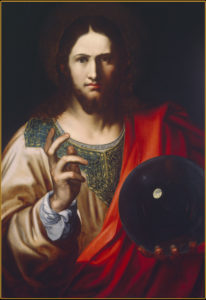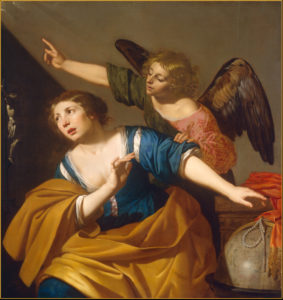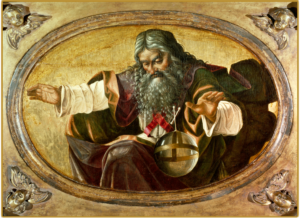God the Father
Tempera on panel
Cristoforo Scacco
Veronese, active c. 1500
Salvator Mundi
Oil on panel
Hendrick Goltzius (attr. to)
Dutch, 1558—1617
St. Mary Magdalene Turning from the World to Christ
Oil on canvas
Jan Hermansz. van Bijlert
Dutch, 1587/98—1671
Technically speaking a symbol is an object that stands for something in addition to itself. However, such a definition hardly captures the depth and beauty that a carefully conceived symbol can add to an artistic work —whatever the genre. The poet William Butler Yeats once remarked, “A symbol is indeed the only possible expression of some invisible essence, a transparent lamp about a spiritual flame.” Philosopher Manly Hall also observed, “Symbolism is the language of the Mysteries. By symbols men have ever sought to communicate to each other those thoughts which transcend the limitations of language.” The orb (or globe) referenced in the following portraits provides a good example. Although in all three works the object serves as a symbol of power, the central character in each painting expands the image in a way that illuminates the symbol’s “invisible essence” and uncovers more of its “Mysteries.”
The painter of this early Renaissance work, Cristoforo Scacco, was born in Verona. Although biographical information on him is scarce, a 1499 document references his presence at the court of the Duchess Lucrezia del Balzo in Campania, the regional capital of Naples which was a thriving cultural and economic center of the time. In this portrait, Scacco portrays God the Father as “the Ancient of Days” clothed in symbolically colored garments—white representing purity, red divine love, and purple royalty. This traditional iconography is in part derived from the prophet Daniel’s dream: “I kept looking Until thrones were set up, And the Ancient of Days took His seat; His vesture was like white snow And the hair of His head like pure wool” (Daniel 7:9). However, it is the cross-bearing orb that accentuates God the Father’s sovereign power as Creator of the world. Notice that the left side of the globe is in darkness, but as the eye sweeps to the right, light “overtakes” that darkness. This imagery, coupled with the figure’s expansive gesture and downward gaze toward the orb, echoes that moment in Genesis as God hovers over the waters contemplating the void before speaking that first divine declaration. It’s but a single phrase: “Let there be light,” and radiant beauty springs forth. This radiance is not only reflected in the orb but also mirrored in the golden background that frames the Creator.
 In this second portrait by the Dutch painter Hendrick Goltzius we shift our focus from the power of Father to that of the Son. Salvator Mundi meaning “Savior of the World,” was a popular subject for painters from the 15th through the 17th centuries. Here Goltzius depicts a vigorous, authoritative Christ. His right hand is raised in His customary sign of blessing, and He is dressed in the symbolic colors of red (love) white (purity) blue (truth) and gold (majesty). As in the previous portrait, this painter uses a globe as his central symbol, but here the orb is predominantly black—darkened by the sin of a fallen world. Notice, however, that its surface is minutely transparent, allowing us to faintly glimpse Christ’s red mantle of love through that darkness. In addition, the orb (an object also held by earthly kings) rests in the palm of Christ’s hand, accentuating the fact that He is not only the Savior but also the ultimate Ruler of the world. The white circle of light “emerging” from the dark orb, further reifies these truths by turning the viewer’s mind to the promised return of the Savior—the Light of the World—who will make “all things new.” One other interesting comparison is that Goltzius’s background (like Scacco’s) mirrors the orb’s symbolism. In this case, the figure is framed against a black background—the halo that surrounds Christ’s head the only “illuminating” detail.
In this second portrait by the Dutch painter Hendrick Goltzius we shift our focus from the power of Father to that of the Son. Salvator Mundi meaning “Savior of the World,” was a popular subject for painters from the 15th through the 17th centuries. Here Goltzius depicts a vigorous, authoritative Christ. His right hand is raised in His customary sign of blessing, and He is dressed in the symbolic colors of red (love) white (purity) blue (truth) and gold (majesty). As in the previous portrait, this painter uses a globe as his central symbol, but here the orb is predominantly black—darkened by the sin of a fallen world. Notice, however, that its surface is minutely transparent, allowing us to faintly glimpse Christ’s red mantle of love through that darkness. In addition, the orb (an object also held by earthly kings) rests in the palm of Christ’s hand, accentuating the fact that He is not only the Savior but also the ultimate Ruler of the world. The white circle of light “emerging” from the dark orb, further reifies these truths by turning the viewer’s mind to the promised return of the Savior—the Light of the World—who will make “all things new.” One other interesting comparison is that Goltzius’s background (like Scacco’s) mirrors the orb’s symbolism. In this case, the figure is framed against a black background—the halo that surrounds Christ’s head the only “illuminating” detail.
 Whereas the previous two paintings use the globe to communicate universal constructs that transcend time, Jan van Bijlert uses the symbol to objectify temptations that beset us “in time.” Here again the globe symbolizes the world, but this world is pictured as a physical rather than metaphysical object—a material world as concrete as the elegant cloth and pearls draped over its surface. Art historian David Steele says, “In this work Bijlert has depicted Mary meditating upon Christ’s sacrifice. The tilt of her head, her upturned eyes, and the upward motion of her hand suggest that she is being drawn upward toward the source of divine illumination to which the angel gestures.” However, the downward thrust of her left arm toward the globe accentuates the “pull of another force” which she is rejecting—a force described in I John 2:12-17: “Do not love the world nor the things in the world. . . For all that is in the world, the lust of the flesh and the lust of the eyes and the boastful pride of life, is not from the Father, but is from the world. The world is passing away, and also its lusts; but the one who does the will of God lives forever.” In Bijlert’s rendering the globe becomes the symbol for this passing world system, the cloth and pearls the beguiling lusts that corrupt one’s love for God.
Whereas the previous two paintings use the globe to communicate universal constructs that transcend time, Jan van Bijlert uses the symbol to objectify temptations that beset us “in time.” Here again the globe symbolizes the world, but this world is pictured as a physical rather than metaphysical object—a material world as concrete as the elegant cloth and pearls draped over its surface. Art historian David Steele says, “In this work Bijlert has depicted Mary meditating upon Christ’s sacrifice. The tilt of her head, her upturned eyes, and the upward motion of her hand suggest that she is being drawn upward toward the source of divine illumination to which the angel gestures.” However, the downward thrust of her left arm toward the globe accentuates the “pull of another force” which she is rejecting—a force described in I John 2:12-17: “Do not love the world nor the things in the world. . . For all that is in the world, the lust of the flesh and the lust of the eyes and the boastful pride of life, is not from the Father, but is from the world. The world is passing away, and also its lusts; but the one who does the will of God lives forever.” In Bijlert’s rendering the globe becomes the symbol for this passing world system, the cloth and pearls the beguiling lusts that corrupt one’s love for God.
Mary Magdalene became an iconic image of penitence in the 16th and 17th centuries. Bijlert’s dramatic lighting, strong diagonal composition, and carefully conceived symbolism make this image one of the most compelling of that time.
Donnalynn Hess, Director of Education
Published in 2020

